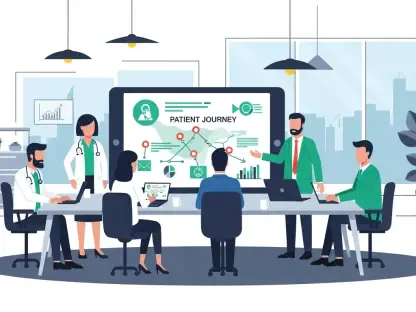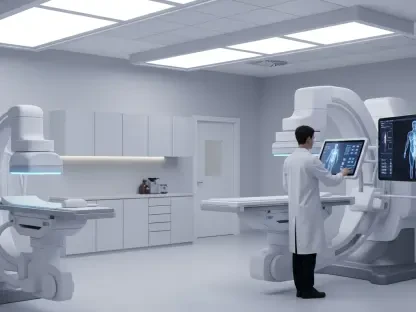Today, we’re privileged to have Faisal Zain, a pioneering healthcare expert renowned for his contributions to the field of medical technology and manufacturing of diagnostic devices. With his extensive experience, Mr. Zain has been at the forefront of innovation, driving progress in medical practices and ensuring better healthcare outcomes. His insights are especially pertinent as we explore the intricate dynamics between healthcare funding, access, and technological advancements.
Can you explain the current impact of Medicare and Medicaid on your practice in the Bronx?
Medicare and Medicaid are critical lifelines for many in the Bronx, providing necessary access to healthcare services that some might otherwise be unable to afford. As an otolaryngologist, I see how these programs enable individuals to engage in early surveillance and treatment, choosing. However, limitations in these services lead to advanced conditions, like incurable cancers or untreated hearing loss, transforming employable individuals into ones struggling to keep their jobs.
What are the specific consequences you foresee if Congress implements the proposed cuts to Medicaid and Medicare?
If these cuts proceed, we can anticipate a significant rise in wait times, fragmented care, or in some cases, an absence of care altogether. For at-risk populations, this means potentially devastating outcomes—a surge in preventable deaths and a deeper despair for families who already struggle with healthcare access.
How do you think these cuts will affect patient care and health outcomes, particularly in at-risk or rural communities?
At-risk and rural communities are uniquely vulnerable due to their inherent challenges in accessing healthcare. Proposed cuts will likely exacerbate these issues, leading to hospital closures and emergency rooms going dark. This forces patients to travel long distances for care, often with urgent needs that cannot be properly met in transit, adversely affecting overall health outcomes.
Why is healthcare access particularly challenging for rural communities, and how might these cuts exacerbate this issue?
Healthcare access in rural areas is already strained due to limited facilities and providers. The cuts would accentuate this problem, leaving even fewer options for residents, pushing healthcare farther out of reach, and endangering lives. Rural America might face longer journeys to seek care and greater difficulty managing chronic conditions without timely intervention.
What compelled you to pursue a career in medicine, specifically in otolaryngology?
My passion for medicine was sparked by a deep desire to impact lives positively. Otolaryngology fascinated me with its intricate connection to senses—hearing, balance, and smell—which are key to a person’s identity and daily function. The opportunity to restore or improve these sensations drives the work I do daily.
How would the proposed cuts change the dynamics of physician-patient relationships in terms of care quality and availability?
Cuts would shift the dynamic by reducing the quality and availability of care, stressing both physicians and patients alike. Physicians may face challenges providing comprehensive care with fewer resources, while patients could feel a loss in personalized attention and timely treatment, which is crucial for effective healthcare delivery.
In your view, why is healthcare considered a human right, and how do insurance coverage gaps undermine this principle?
Healthcare as a human right reflects the belief that everyone should have access to essential health services to maintain life and dignity. Coverage gaps inherently undermine this principle, leaving individuals to delay or forego care, resulting in preventable suffering and exacerbation of medical conditions that could have been managed or prevented.
Can you elaborate on the administrative and reporting burdens that might arise from these cuts?
With cuts, we anticipate increased administrative hurdles, requiring clinicians and patients to navigate complex eligibility confirmations. This bureaucratic strain could lead to coverage loss for patients, placing a heavier burden on medical staff who will have to manage these operational challenges amid heightened patient care demands.
What are the potential impacts of new co-pay obligations on patients with limited financial resources?
Introducing new co-pay obligations would place an undue burden on patients with scarce financial means, possibly deterring them from seeking necessary medical interventions, exacerbating health disparities, and leading to conditions that are expensive and difficult to treat later on.
How are children and families in New York, especially in rural areas, currently relying on Medicaid?
In New York, Medicaid is a critical source of coverage for many children and families, especially in rural communities. It provides economic security for low-income working families who often lack employer-provided insurance, ensuring their children receive necessary medical attention and a consistent standard of care.
Can you discuss the state of rural healthcare and how the proposed cuts might worsen the crisis facing rural hospitals and nursing homes?
The crisis in rural healthcare is undeniable, with hospitals and nursing homes teetering on the brink of closure. Proposed cuts would fuel closures, further limiting access to essential services, resulting in even fewer healthcare options for rural families, who already face significant barriers to obtaining care.
What adjustments would you suggest for Congress to better support Medicaid without compromising necessary coverage?
Congress should focus on strategic cuts that target inefficiencies without sacrificing coverage. This involves rooting out fraud, reassessing bureaucratic processes to streamline access without affecting care quality, and considering careful recalibrations to ensure that vulnerable populations remain protected.
How has Medicare physician pay been affected over the years, and what have been the repercussions for medical practices?
Medicare physician pay has drastically declined over the past 24 years, leading to challenges in maintaining practice operations as costs surge with inflation. This puts immense pressure on physicians, contributing to practice closures and increased wait times, which erode the quality of patient care.
Why do you think hospitals and Medicare Advantage Plans receive inflationary adjustments while physician payments continue to decline?
Hospitals and Advantage Plans benefit from inflationary adjustments as they are perceived as institutional necessities. However, neglecting similar adjustments for physicians undermines the pivotal role they play in patient care, leading to systemic financial strains impacting service delivery.
In your opinion, how does the lack of inflation-based physician payment adjustments influence healthcare quality?
Without inflation-based adjustments, physicians struggle to meet operational costs, risking a decline in care quality due to overburdened practices and reduced access to medical innovations. Patients suffer increased waits and limited availability, weakening the overall healthcare framework.
What legislative actions do you believe Congress should prioritize to address the issues of healthcare funding?
Congress should prioritize legislative actions that ensure equitable funding, focus on inflation-based payment adjustments for physicians, and promote policies that alleviate reporting burdens, while targeting waste and inefficiencies within the healthcare system to maximize resource utilization.
How have physician wait times and private practice closures affected your community?
Physician wait times and closures restrict access, forcing patients to delay critical care and weakening community health infrastructure. These issues compound the stress on remaining practitioners, adversely affecting the cohesiveness and reliability of the care delivery system in the Bronx.
How can improved funding for physicians and providers prevent expensive medical outcomes and enhance patient recovery?
Equitable funding promotes preventative care measures that intercept progression to severe disease states. Adequate resources allow prompt treatment of injuries and conditions, supporting quicker recovery and minimizing the need for costly hospitalization or long-term intervention, benefiting individuals and the healthcare system alike.
As President of the Medical Society of the State of New York, what are your primary advocacy goals regarding these healthcare cuts?
Our goals revolve around safeguarding essential coverage, ensuring that legislative changes do not unduly burden vulnerable populations, advocating for fair physician payment models, and championing reforms that bolster the provision of high-quality, sustainable healthcare.
How do you balance your professional responsibilities with your roles in medical organizations like the Medical Society of the State of New York and the American Medical Association?
Balancing these roles involves a commitment to prioritizing patient care while dedicating strategic time to advocacy and organizational leadership. It requires integrating insights from clinical practice with broader policy objectives to harmonize direct patient interactions with systemic improvements in healthcare delivery.









